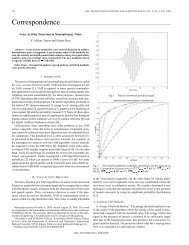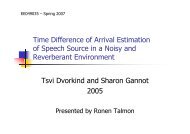Thesis (PDF) - Signal & Image Processing Lab
Thesis (PDF) - Signal & Image Processing Lab
Thesis (PDF) - Signal & Image Processing Lab
Create successful ePaper yourself
Turn your PDF publications into a flip-book with our unique Google optimized e-Paper software.
90 CHAPTER 6. EXTREMA-WATERSHED TREE EXAMPLE<br />
(a) (b)<br />
Figure 6.16: Trenches meaning. (a) Trench example (b) An infimum of A and B, is a<br />
common father E. Its sons, C and D are the roots of subtree1 and subtree2. Pruning<br />
the tree to C and D vertices, will create the required segmentation.<br />
segmentation. The idea behind the presented method is to prune the tree, leaving<br />
only the main objects. The tree is self-dual, and so is the resulting segmentation.<br />
The implicit segmentation is based on the “trench” phenomenon. This phe-<br />
nomenon is described in Chapter 4. The trench is created, during erosion, on the<br />
border of two very different zones. The difference is defined by the path-distance<br />
to the common parent. The trench opens a gap with the gray level of the common<br />
parent. The sub-trees (the descendents of the common parent) are image segments.<br />
We are going to use this feature to find basic components of an image as shown in the<br />
example in Fig. 6.16(b). As one can see, common parent of two different subtrees, has<br />
two sons, where each of them is the root of the corresponding subtree. An example<br />
of a trench that opens between two zones in the Lena image is shown in Fig. 6.16(a).<br />
If we take only those son labels, and prune every other label beneath, a segmented<br />
image is created.<br />
The tree-depth image, is the map of depths in the tree associated to each label<br />
in the image. In order to obtain trenches, another definition is required. The trench
















